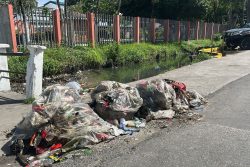Having received government and regulatory approvals, ExxonMobil yesterday announced that it has funded its Liza Phase 2 development project offshore Guyana and it is expected to cost US$6 billion and produce up to 220,000 barrels of oil per day, with startup expected in mid-2022.
The final investment decision for Liza 2 had been delayed following extended negotiations between Exxon and local regulators.
Last week, Neil Hansen, Vice President of Investor Relations and Secretary of ExxonMobil, had said that a final investment decision was expected soon subject to government and regulatory approvals. Subse-quently, Stabroek News reported on Monday that the Environmental Protection Agency had, following intense negotiations, granted the necessary environmental permit and Head of the Department of Energy (DoE) Dr Mark Bynoe, at a press conference yesterday, disclosed government approved the Field Development Plan (FDP) for Liza Phase 2 on Monday.
In a statement shortly after Bynoe’s press conference, ExxonMobil announced that it has funded Liza Phase 2.
Bynoe, who was accompanied by Oil and Gas Government Advisor Matthew Wilks, highlighted that the approval is subject to a number of conditions and confirmatory studies, including the implementation of precautionary measures in the event of a potential oil spill.
Liza Phase 1 is underway, with first oil expected in the first quarter of next year and for Phase 2, Bynoe said that among the conditions is that ExxonMobil will have to establish a Regional Capping Stack or other solution to ensure that a Capping Stack can be deployed within five days of a well control event with loss of containment.
He said that ExxonMobil’s local subsidiary, Esso Exploration and Production Guyana Limited (EEPGL), will have to follow the required practice in the US Gulf of Mexico in calculating “Worst Case Discharge” and to validate the assumptions and calculations by obtaining an independent assessment to develop an estimate of the flow that would result from an open hole well control event with loss of containment.
“This independent assessment will then be used as the basis for the oil spill response plan and oil spill modelling,” Bynoe said. He also pointed out that EEPGL will have to conduct annual third-party auditing on their drilling operations that would be consistent with good international oilfield practice and its own Operations Integrity Management System.
The conditions also require Exxon to improve the targeted availability of the overall production system of the Liza Phase 2 Floating Production Storage and Offloading (FPSO) to between 98 and 99 per cent. As well, Exxon will have to identify potential cost savings synergies between Liza Phase 1 and Lisa Phase 2 and has to, with its partners Hess Guyana Exploration Ltd and CNOOC Nexen Petroleum Guyana Limited, enter into a Decommissioning Security Agreement.
Bynoe said that the DoE and the Guyana Geology and Mines Commission’s Petroleum Division together with its external consultant, Bayphase, conducted the in-depth review of the Liza Phase 2 FDP. He observed that it will utilise a development concept similar to the Liza Phase 1 FDP, where subsea wells and a FPSO vessel will be utilised.
‘Significant development potential’
Meanwhile, in its statement issued shortly after Bynoe’s press conference yesterday, Exxon said that Liza Phase 2 will produce up to 220,000 barrels of oil per day and further capitalise on the significant development potential of the Stabroek Block, where the company estimates producing more than 750,000 barrels of oil per day by 2025.
It echoed statements by Bynoe that a total of six drill centres are planned as well as approximately 30 wells, including 15 production, nine water injection and six gas injection wells. “Phase 2 startup is expected in mid-2022 and will develop approximately 600 million barrels of oil. Liza Phase 2 is expected to cost $6 billion, including a lease capitalization cost of approximately $1.6 billion, for the Liza Unity [FPSO],” the statement said.
“With the government of Guyana and our partners, ExxonMobil is bringing industry-leading upstream capabilities to build upon Phase 1 and further develop the shared value of Guyana’s resources,” Liam Mallon, president of ExxonMobil Upstream Oil & Gas Company, was quoted as saying. “We are actively pursuing significant development potential from numerous discoveries in the Stabroek Block,” he added.
The statement noted that Liza Phase 1 remains on track to achieve first oil by the first quarter of 2020. It will produce up to 120,000 barrels of oil per day at peak rates, utilising the Liza Destiny FPSO, which is expected to arrive offshore Guyana in the third quarter of 2019.
The statement said by the end of 2019, Exxon will have four drillships operating offshore Guyana. Following well completion activities at the recently announced Yellowtail discovery, the Noble Tom Madden will move to the Hammerhead-2 well. The Stena Carron is completing a well test at the Longtail-1 discovery, and will then move to the Hammerhead-3 well, it said.
It added that later this year, the Stena Carron will drill a second well at the Ranger discovery. Further, the Noble Bob Douglas drillship is completing development drilling operations for Liza Phase 1. ExxonMobil will add another exploration drillship, the Noble Don Taylor, in the fourth quarter of 2019, the company said.
“As the projects proceed, the partners’ investment in the Guyanese economy continues to increase. The number of Guyanese nationals supporting project activities more than doubled in 2018 to more than 1,000. ExxonMobil and its co-venturers spent nearly US$60 million with more than 500 Guyanese vendors in 2018. More than 1,500 Guyanese companies are registered with the Centre for Local Business Development, which was founded by ExxonMobil and its co-venturers in 2017 with the mission of supporting local businesses to become globally competitive,” it added.
The company also disclosed that pending government and regulatory approvals, a final investment decision is expected later this year for a third phase of development, Payara, which is expected to produce between 180,000 and 220,000 barrels per day, with startup as early as 2023. ExxonMobil is evaluating additional development potential in other areas of the Stabroek Block, including at the Turbot area and Hammerhead, the statement said.
It noted that the Stabroek Block is 6.6 million acres, or 26,800 square kilometers. Current discovered recoverable resources are estimated at more than 5.5 billion barrels of oil equivalent. The 13 discoveries on the block to date have established the potential for at least five FPSO vessels producing more than 750,000 barrels of oil per day by 2025.
Additionally, Bynoe also noted that government on April 30th approved the farm-in joint venture agreement between CGX Energy Inc and Frontera Energy Co covering two shallow water offshore petroleum prospecting licences in the Corentyne and Demerara Blocks. CGX is expected to drill one well later this year using a jack-up rig.










